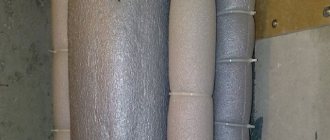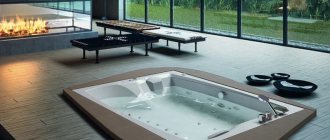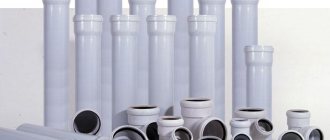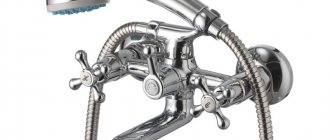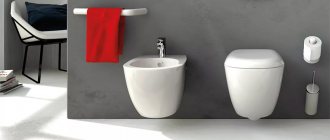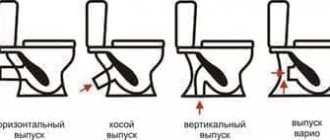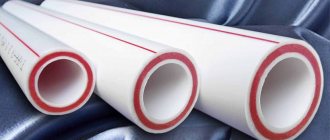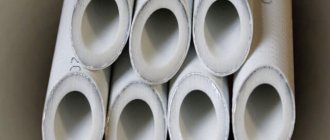The morning of every modern person begins with the bathroom. Our mood for the whole day largely depends on how we spend it. This means that comfort and a pleasant atmosphere at the beginning of the day are very important for any of us. How to create such conditions in the bathroom? Of course, with the help of room design, tastefully selected furniture, as well as beautiful and high-quality plumbing fixtures.
The bathtub is rightly called the “heart” of the bathroom. This is an important attribute of any home and the very first thing that catches our eye when we enter the bathroom. When renovating, it is very important to choose a high quality product that matches the tastes and interests of your family. Before choosing, you need to weigh the pros and cons, since changing something in the bathroom interior will be an extremely time-consuming and expensive task.
Today, bathtubs made of cast iron and acrylic occupy leading positions in sales. Both options differ in quality and convenience , however, there are differences between them. Getting to know the advantages and disadvantages of each product, as well as comparing their main characteristics, will help you understand what is right for you.
- 2 Advantages and disadvantages of acrylic bathtubs
- 3 Comparison of main characteristics
- 4 And yet, cast iron or acrylic?
What are cast iron, steel and acrylic bathtubs?
Cast iron
Durable and reliable products made of cast iron (an alloy of iron and carbon) that retain heat well were the very first to appear. And this happened in 1925, in Spain, near Barcelona. The Roca brothers decided to expand the range of their plant producing cast iron radiators by starting production of cast iron bathtubs. To this day, ROCA is one of the recognized world leaders in this area. The products of this brand are distinguished by high quality, durability and a variety of colors.
In Europe, there is a noticeable decrease in the total number of cast iron products; they are gradually being replaced by steel baths, which are easier to transport, cheaper and more environmentally friendly to manufacture. Only a few companies produce cast iron bathtubs. The most famous are Jacob Delafon, PORCHER, and ROCA. In Russia and other CIS countries they are still produced in large quantities, but in only a couple of standard sizes, and also with a small selection of shades.
Note that European cast iron products have a more beautiful and varied design. For example, there may be handles on the side or armrests, the bottom is increased by changing the angle of one of the backs. Sometimes one backrest is removed altogether for convenience. And the design of imported products can be anything: from classic with the possibility of embedding to luxurious English style.
A properly made cast iron bathtub should have walls of at least 0.5 centimeters and strong enamel, applied at the factory in two steps. The cast iron alloy contains certain amounts of manganese, silicon or sulfur, which give it additional strength. The enamel coating can last from 10 to 30 years, possibly longer (depending on the load).
+ Pros of cast iron baths
- Huge service life (up to half a century);
- Resistance to aggressive influences;
- Heat retention;
- No pores on the surface;
- Silence;
- Color depth;
- Easy to clean.
— Disadvantages of cast iron baths
- Heavy weight;
- Difficult to transport, carry for installation and install;
- Lack of variety in configurations. They can only be made rectangular or oval.
Steel
In terms of cost, a steel bathtub is more attractive than a cast iron one. Moreover, the price may differ by two or three times. This is sometimes a powerful argument when deciding which bathtub is better - cast iron or steel. In addition, many consumers like that products made of steel can take almost any shape. In addition to the traditional rectangular and oval (like cast iron), these are very convenient and compact corner designs, as well as polygonal, round, and asymmetrical.
Similar products are made from steel sheets with a thickness of 0.23 centimeters (thin-walled bathtubs) to 0.35 centimeters (standard bathtubs). The acrylic-based enamel that covers the surface of steel is less thick than that of cast iron. But modern technologies for its application make it possible to create a fairly reliable and durable coating.
Among the foreign companies producing high-quality steel products, we can note the Finnish company Ido, the French - Porcher and Jacob Delafon, the German - Bamberger and Kaldewei, the Italian - Ariston, the Spanish - ROCA. They weigh from 25 to 30 kilograms, are elegant in design and have a good enamel coating. Bamberger especially uses a lot of innovative technologies. For example, “Anti-slip” coating, which prevents slipping, “Enamel-plus”, which repels dirt. The warranty on bathtubs is 30 years.
+ Advantages of steel bathtubs
- Not too high a price;
- Variety of shapes and sizes;
- Wear-resistant coating;
- Light weight.
— Disadvantages of steel bathtubs
- They do not hold heat as well as cast iron;
- Too “loud” (the ringing noise of water being poured is clearly audible);
- Able to bend under the body of a heavy person.
Acrylic
This material began to be used for the production of bathtubs later. Its full name is methyl acrylate. It is a synthetic polymer and is made from acrylic acid. The result is a substance that is resistant to abrasion, ultraviolet radiation and oxygen. Its surface is pleasant, smooth and warm to the touch.
To make a bathtub from acrylic, use one of two methods:
- They take an acrylic sheet of the appropriate size, and then bend it in a vacuum chamber as needed. The resulting container is not very strong: its walls bend easily, and when pouring water they may swell. Therefore, the bathtub needs to be strengthened: its surface is coated with epoxy resin in several layers, lined with fiberglass. The more layers, the stronger the bathtub.
- Molding technology involves the use of a fiberglass frame onto which acrylic is applied. The result is an immediately more durable product than one made using the method described above.
In any case, a “correct” acrylic bathtub should have a wall thickness of at least 4-6 millimeters. When you tap on its sides, the sound should not be too loud. This may mean that the manufacturer cheated by deciding to save on the reinforcement process. Next, we will mention manufacturers who produce high-quality acrylic products. These are the Czech company Ravak, Polish - Cersanit and Kolo, Spanish - Pool Spa, Dutch - Riho, German - Duravit, Russian - Aquanet.
When, before arranging his bathroom, the owner of the apartment decides which bathtub is better - acrylic or cast iron, he often outweighs acrylic. Because of its lightness, beautiful and varied shape.
Construction of an acrylic bathtub and its frame.
+ Pros of acrylic bathtubs
- Acrylic retains heat well;
- The abundance of all kinds of modern devices (for example, hydromassage) makes acrylic bathtubs one of the most functional;
- Light weight;
- Huge selection of shapes and sizes.
— Disadvantages of acrylic bathtubs
- Difficulty in care;
- May sag during use;
- Fear of acrylic at too high temperatures;
- Short service life compared to cast iron and steel models.
Steel bath: budget option
Bathtubs made of steel are generally cheaper than models made of cast iron and acrylic and are lighter in weight. In terms of variety of shapes they are inferior to acrylic ones, but superior to cast iron ones due to the plastic properties of the material.
Manufacturing of steel baths
At the beginning of the 20th century, in the production of plumbing fixtures, steel sheets were welded together in the shape of a more or less oval body. In the middle of the century, the German company Kaldewei proposed its own development - the first seamless model, which was stamped from a single sheet 3.5 mm thick.
The enamel is applied in a special oven at a temperature of 850 °C. Under such conditions, the coating is literally baked into the steel base and does not peel off over time and does not lose its whiteness during use. Manufacturers provide a 10-year guarantee for products with a thickness of 2.3 mm, and 30 years for products with a thickness of 3.5 mm.
In a debate about which bathtub is better: acrylic, steel or cast iron, the reliability of the manufacturer is of great importance. Models of leading enterprises are presented on the modern market:
- Elite ones include plumbing products from the German company Kaldewei and the Spanish company Roca;
- European brands BLB (Portugal), Emalia (Poland), Estap (Slovakia) are more accessible;
- In Russia, steel bathtubs are produced by Verkh-Isetsky Metallurgical Plant, Yekaterinburg).
Advantages
- Weight. The steel font is quite light, with an average weight of 30 kg. So transportation and installation will not cause any particular difficulties.
- Strength. A steel bathtub is quite rigid and, when installed correctly, stable and difficult to damage during use. It courageously withstands temperature changes and cleaning with various detergents. Under favorable operating conditions, it will last up to 15 years; the German company gives a 30-year guarantee on its models.
- Choice. Steel allows you to stamp bathtubs of both the usual rectangular shape and non-standard, angular, oval models (there are many of these in the Kaldewei line).
- Price. In the low and medium price range, steel bathtubs are half the price of cast iron ones. This should be taken into account when asking which bathtub to choose – cast iron, acrylic or steel.
Flaws
- Risk of deformation. The walls of a good bath are made of steel no thinner than 3 mm. If this figure is less (1.5 - 2.3 mm), the case may very soon change shape, and the enamel coating may crack. Dents and chips appear on the surface.
- High heat dissipation. The water in a steel bath heats up quickly and cools down just as quickly. You won’t be able to relax and lie down here after a hard day at work, except by constantly adding hotter water.
- Poor sound insulation. This is the main disadvantage that consumers complain about. When filling with water, the bathtub rings loudly, the same effect occurs if you accidentally touch and hit the body with something. Some manufacturers sell special noise-absorbing linings: they are attached from the outside along the entire body of the product, and so that the appearance does not suffer, the bath is covered with a protective screen.
- Instability. Due to its light weight, a steel bathtub requires reliable fixation. It is better to abandon the installation legs and place the bath on a base made of bricks.
When analyzing the disadvantages of steel structures, in the question: which bathroom is better, you need to remember the folk remedy for combating noise and heat loss. Owners of such bathtubs apply a thick layer of polyurethane foam to the outside of the bathtub; it should provide additional thermal insulation and muffle the sounds of pouring water. The result will not look very attractive, so you will need to install a decorative screen.
Two types of steel baths
In the production of plumbing fixtures, two types of steel are used: structural or stainless steel.
- Enameled models familiar to everyone are made from structural steel.
- Stainless steel bathtubs are more expensive and will last longer if cleaned regularly. Steel does not corrode.
How to choose a steel bathtub?
- You need to check the wall thickness using a simple test: try to move the sample right in the store. If the bathtub is of high quality with a steel thickness of 3.5 mm, its weight will be 30-50 kg, and it will not be possible to move it or will be very difficult. And when a model of standard dimensions 1700 x 700 mm weighs about 20 kg, this means that there is not much steel here.
- If you tap the bathtub in different places, the response sound should be smooth, without rattling, clanging, or extraneous vibrations. This technique is very useful when you need to choose which bathtub is better: acrylic, steel or cast iron.
- High-quality internal surface - completely smooth, without depressions or bulges, enamel coating - without chips, smudges or other defects.
Review of prices for steel bathtubs
From a small comparison it can be seen that bathtubs of small and standard sizes from manufacturers cost almost the same. And Slovak, Polish and Russian products in the product line from cheap to expensive models are kept in the same price range. Their size range is limited, as a rule, to small and standard dimensions.
The products of the Ekaterinburg enterprise "VIZ" under the separate brand Donna Vanna are distinguished by a variety of colors: pink coral, blue lagoon, mint green, Caribbean pearls, sea wave, etc. (the manufacturer claims a steel thickness of up to 2 mm).
| Manufacturer | The cheapest models | Standard models | The most expensive models |
| Kaldewei (Germany) | from 5,017 rub. | from 12,923 rub. | from RUR 391,479 |
| Roca (Spain) | from 4,681 rub. | from 7,600 rub. | from 58,400 rub. |
| BLB (Portugal) | from 4,560 rub. | from 7,520 rub. | from 122,810 rub. |
| Emalia (Poland) | from 4,990 rub. | from 6,750 rub. | from 6,750 rub. |
| Estap (Slovakia) | from 4,270 rub. | from 4,600 rub. | from 5,343 rub. |
| VIZ (Russia) | from 4,345 rub. | from 7,990 rub. | from 7,990 rub. |
| Donna Vanna (Russia) | from 4,776 rub. | from 5,107 rub. | from 5,239 rub. |
Easy to install
Bringing a heavy cast-iron bathtub into the house is not so easy - one person cannot do it. This explains the difficulty in installing such products. They also need to be firmly fixed on a flat plane. They are usually placed on four cast legs.
To install an acrylic bathtub, you will need to assemble a metal frame and only after installing the bathtub on the frame can it be connected to the sewerage system. This makes the installation process somewhat difficult, but since all the parts are light, one person can handle it quite well.
Steel bathtubs are also fixed on legs, but their installation can be done by one person. To significantly increase sound insulation, a layer of polyurethane foam is often applied to the surface of the product or the bottom is covered with Penofol. In general, installation of a steel bathtub is the easiest.
Sound insulation of a steel bath: on the left with Penofol, on the right with polyurethane foam.
Steel bath
Acrylic bath
Cast iron bath
Results. Steel bathtubs can be called the easiest to install (however, in the case of applying polyurethane foam, the process becomes somewhat more complicated). The second place belongs to acrylic bathtubs, where you will have to tinker with making the frame. And the rating is completed by cast iron products, heavy and bulky.
How to choose a high-quality cast iron bathtub?
First, you should resolve all connection issues. In cases where the decision is made to replace the entire sewer system, the bathtub must be selected so that the drain pipe clearly coincides with the bathtub drain hole. The dimensions must be selected so that emergency replacement of pipes can be easily carried out. By the way, they need to be selected after choosing a bath.
Which cast iron bathtub should you choose? The main factor is the quality of the product. If you have already made a choice in favor of a certain model, now you need to evaluate the quality, for which you should carefully study the following: The internal coating must be extremely even and smooth. Light waves on an enamel coating are allowed. The outer walls should not have defects such as chips and cracks.
When choosing a color, you need to pay attention to its uniformity. The coating must not have paint defects.
Easy to care for
If the enamel is applied to cast iron with high quality and has a sufficiently thick layer, then the coating is very durable. And even if the stain has penetrated deep into the enamel, it can be removed in almost any way, including chemical reagents and mechanical action. And housewives do this with great success.
Steel products are coated with thinner enamel, which, accordingly, needs to be cleaned more carefully than in the previous case. Especially when using abrasive products. Otherwise, you can damage the surface, which will be difficult to restore later.
Acrylic bathtubs are cleaned carefully, using mild care products and without using strong abrasives or aggressive chemicals. This will prevent the formation of cracks and premature failure of the product.
Cast iron bath
Steel bath
Acrylic bath
Results. On this point, our products made of cast iron turned out to be the most unpretentious, and acrylic ones modestly retreated to the very last place, third. Steel baths took the middle position. However, the steel models mentioned above, coated with the innovative “Enamel-plus” composition, can also very well lay claim to the position of leader in ease of maintenance.
Life time
It’s not for nothing that cast iron products are still popular - after all, they are destined to please their owners for at least 50 years, and this is a very decent period. Steel bathtubs can safely last 20-30 years. Products made from cast acrylic last for at least 15 years. But provided that their walls have a thickness of at least 4 - 5 millimeters.
Cast iron bath
Steel bath
Acrylic bath
Results. Cast iron has firmly established itself in our leading position - its durability is beyond doubt (but technology must be followed in the manufacture of this material). Steel bathtubs are again in the middle of the ranking, and acrylic products are in last position.
All about acrylic bathtubs
To understand which bathtub is better, acrylic or steel, you need to study all the options. Acrylic bathtubs have different performance characteristics, despite the fact that they are all made from acrylic sheets. To make the base, ABC plastic, polymethyl methacrylate (PMMA) or a complex containing both components is used. From the resulting sheets, a product of the desired shape is created under vacuum conditions.
To produce high-quality bathtubs, polymethyl methacrylate is used; depending on the manufacturing method, the base can be of two types:
- Cast acrylic sheets
are produced by pouring molten polymer between two rigid panels and then curing it into that mold. At the exit from the production line, sheets of sanitary acrylic are formed, which are able to withstand strong mechanical loads. The material is characterized by the evenness of the sheet over the entire area and minimal shrinkage when heated. - Extruded acrylic sheets
are produced by squeezing molten polymer through a special slot nozzle. The finished material is characterized by high porosity, it is less dense and does not withstand strong impacts.
As for the cost, bathtubs made of cast acrylic will cost more than products made from extrusion material. However, it should be taken into account that the technical and operational characteristics of the first option are much higher. It is almost impossible to detect external differences between sanitary containers, so you need to be very careful when choosing a product.
The production of acrylic bathtubs from both types of acrylic sheets involves the use of a single technology. According to the technological process, the bowl is first formed under vacuum pressure. Next, the back of the container is reinforced with fiberglass. Then the technological holes are cut out and the sides of the bath are formed.
Bathtubs made of ABS polymer material, whose name is acrylonitrile butadiene styrene, can be classified as cheap and impractical products. The material does not withstand processing in the form of grinding, however, its high porosity allows products made from it to be painted in different colors. The porosity and hygroscopicity of ABS plastic contribute to rapid destruction from contact with moisture. For this reason, the products have a fairly short service life. The thickness of the top acrylic layer can vary; as this layer decreases, the surface becomes more vulnerable to deformation and damage. In other words, a thin polymer layer can be easily pierced with a sharp object or erased with frequent cleaning.
Plumbing containers made from a combined material are produced by passing ABS and PMMA polymers through an extrusion nozzle. The resulting two-layer panel has technical and operational characteristics intermediate between standard extruded PMMA and injection molded PMMA.
Degree of coating protection
This point is quite closely related to product care, so let’s repeat it a little. As already mentioned, the enamel used to cover cast iron is distinguished by a smooth surface, resistance to various reagents and mechanical stress. When making high-quality cast iron bathtubs, specialists carefully check the quality of the enamel at each stage, applying it in a layer of 0.8 to 1.2 millimeters. Firing occurs at a temperature of 110 degrees. So the protection of such a bath is “one hundred percent.”
The enamel on steel bathtubs is also of good quality, but due to its thinner layer, the protective coating is somewhat less reliable than in cast iron products.
Acrylic is quite fragile; it does not like having something heavy thrown on it. Because of this, cracks may appear. Which, of course, are quite amenable to restoration, but all this adds trouble. In addition, stains from various dyes and scratches very easily remain on the surface of acrylic. Of all the coatings, acrylic should be treated most sparingly.
Cast iron bath
Steel bath
Acrylic bath
Results. And again the team with cast iron bathtubs wins the gold medal; second place, according to tradition, goes to steel bathtubs; third place goes to acrylic bathtubs.
Variety of sizes
Cast iron bathtubs made in Europe can have a length from 150 to 180 centimeters and a width from 60 to 90 centimeters. The standard length of the lower (inner) part is 110-120 centimeters. Modern technologies (changing the angle of the backrest, for example) make it possible to increase this size to 130-140 centimeters. Domestic cast iron bathtubs are made with a width of 70 centimeters and a length varying from 120 to 150 centimeters.
The variety of shapes of steel and acrylic products also implies a variety of sizes. As an example, let's take steel baths produced by the German company Kaldewei. The large model of this brand, Corpostar, has dimensions of 190 by 90 centimeters, and the small Miniform model has dimensions of 157 by 70 centimeters. The Japanese-style Kusatsu Pool model is distinguished by its increased depth (81 centimeters) and compactness (140 by 100 centimeters).
Bathtubs made from acrylic are equally varied in size. They can be large and small, wide and narrow, deep and not very deep. Corner and round options are available with different side sizes and diameters. If we talk about rectangular and oval models, their bowl can have a width from 70 to 170 centimeters, and a length from 120 to 190 centimeters.
Acrylic bath
Steel bath
Cast iron bath
Results. More modern steel and acrylic are again in the lead, leaving behind the good-quality but conservative cast iron. They make it possible to choose a product for any bathroom and for any purpose. For example, a large round bathtub can easily be used for two people at once. A compact corner option is for a small apartment.
Installation types
There can be three options: installation along one of the walls (the most common), corner placement and installation in the middle of the room. The latter option is used for large bathrooms when using large oval or round bathtubs. Which are often equipped with hydromassage and other pleasant extras.
Corner models are produced both symmetrically and with different sizes of sides adjacent to the walls. As a rule, the side opposite the corner is rounded. It is not only practical, but also looks beautiful.
Cast iron bathtubs, as a rule, are placed along the wall, less often they are placed in the center of the room. Due to the design features, they cannot be installed in a corner. As for steel and acrylic products, they can be mounted in any of three options. Finding the right model is not a problem.
Acrylic bath
Steel bath
Cast iron bath
Results. Once again we have two leaders - steel and acrylic products have more options regarding the type of installation. The cast iron baths remained in the shadows.
Criterias of choice
Let us highlight several important characteristics with which you can compare plumbing fixtures.
- Life time. This indicator affects the durability of the selected bath. If you purchase a cheap product, then in the long run the savings will turn into additional expenses. The longer the bathtub lasts, the less you will have to spend subsequently: on repairs, dismantling, purchasing and installing a new bathtub.
- Care and cleaning. The bathtub has to be washed daily, so caring for it turns into a grueling task if the material is too fancy. Ease of care depends on the composition and thickness of the enamel covering the surface of the product.
- Variety of shapes and sizes. Bathrooms of different sizes require different bath models: you need to take into account the width, length, height and shape of the product. Sometimes a small or asymmetrical bowl is the only way to comfortably accommodate all the necessary items in a cramped bathroom. There are not only standard rectangular fonts on sale, but also angular, multifaceted, round and shaped products.
- Practicality. The bathtub should not deform from exposure to hot water and sag under a person during use. This also includes the ability to withstand mechanical stress.
- Convenience. This criterion is responsible for comfort during water procedures: how long does the tank keep warm? Does the bowl make more noise when filling the bathtub? Is it possible to install additional options such as hydromassage and water level sensor?
- Installation. Some products are easy to install and connect yourself, but in other cases you will have to spend money on a specialist. Also, some bowls require additional metal legs or a frame.
- Weight. Most often, this indicator is paid attention to when purchasing a cast iron bathtub. A heavy product makes transportation and installation difficult. Before purchasing, you should consider the details of delivery: will you need a special car and loaders? Will the tank fit in the elevator? If the weight of the bathroom is high, then transportation becomes an additional expense.
- Price. For many buyers, the cost of the product is the main factor when choosing a bathtub. The problem lies in the fact that with this approach the design may not meet even minimal expectations and will soon lose its appearance.
Ease of use
Here we will consider what degree of comfort products made from various materials give us. Let's start with the temperature of the water - for a pleasant swim it is important that it does not cool down longer. Good old cast iron is very good in this sense - it keeps water warm for a long time. However, modern acrylic can also boast of good heat conservation. But steel - alas - quickly cools water. In addition, it has another drawback - it rattles loudly when the bath is filled. Cast iron and acrylic are very quiet.
Bathroom walls made of cast iron will never sag. Now let’s look at the following two products based on this parameter, determining which bathtub is better—an acrylic or a steel bathtub. Steel can easily hold its position without sagging under the weight of the body, which cannot be said about acrylic. Deflection of the walls is its main drawback; the metal frame on which the bathtub is mounted is designed to cope with it. This is most relevant for overweight people.
Cast iron bath
Acrylic bath
Steel bath
Results. According to the parameters under consideration, the most convenient are cast iron products. Acrylics are not without drawbacks in this regard, so they can share second place. Steel bathtubs are somewhat inferior to acrylic bathtubs in this regard, but in some cases they can perform on an equal footing. Also, bathtubs made of steel and acrylic are often equipped with all sorts of comfortable seats, handles, and armrests.
Acrylic or cast iron?
Exquisite design or strict classics? Habitual reliability or challenging stereotypes? The confrontation is serious, and therefore the doubts of buyers are justified.
Cast iron bathtubs have been and remain in trend, therefore they are in great demand among clients of plumbing stores. In Russia, 50% of all bathtubs purchased are cast iron products. The main purchase criteria here are durability and strength.
Acrylic bathtubs are also popular in the sanitary equipment market, but thanks to the unique properties of the material from which they are made.
Comparison of metal and sanitary acrylic
Acrylic has low thermal conductivity and low weight, resistance to humid environments and low maintenance requirements. It inhibits the proliferation of bacteria and microorganisms and is harmless to humans.
Acrylic is pleasant to the touch, warm material with a perfectly smooth surface. You can take water treatments in an acrylic bathtub for a long time: the water will cool slowly, and when the bathtub is filling there is no noise at all. Acrylic bathtubs are created taking into account the anatomical features of the human body, thanks to which maximum comfort is achieved during the use of the product.
Consumer qualities of cast iron: advantages of metal
- silent filling;
- thermal inertness;
- resistance to temperature changes;
- material strength;
- environmental friendliness.
The disadvantages of cast iron still outweigh its minor advantages.
The weight of cast iron baths can reach 150 kg
. An average bathtub with classic dimensions of 170*70 weighs about 110 kg, so there are many problems during transportation. This makes installation of the product significantly more difficult.
When caring for small children, the bottom of a cast-iron bathtub must be covered with special mats, since the surface of the material is cold.
Device weight
The heaviest are bathtubs made of cast iron. They weigh at least 120-130 kilograms. Such a significant weight (sometimes reaching up to 150 kilograms) provides good stability, but significantly complicates installation work. Which will cost more than installing a steel or acrylic bathtub.
A European-made steel bathtub with walls from 2.5 to 3 millimeters is much lighter than a cast iron one, several times lighter. Her weight is approximately 25 to 30 kilograms.
The most “weightless” material can be called acrylic. If a bathtub made from it has a length of 150 centimeters, then its weight ranges from 15 to 20 kilograms. Products with a length of 170 centimeters weigh from 20 to 25 kilograms. By the way, when purchasing, pay attention to this: a bath that is too light, and whose weight differs greatly from these indicators, may turn out to be of poor quality. Otherwise, the manufacturer cheated by making a product with fewer reinforcing layers than it should have.
Acrylic bath
Steel bath
Cast iron bath
Results. In first place we will define acrylic products. On the second - steel baths, and on the third - cast iron, completely heavy.
Price
Let's start again with cast iron appliances. Domestic models without any special bells and whistles will cost $50-70. European baths will cost more: $200 and up. The price for premium collections from PORCHER and Jacob Delafon can reach up to $450-700.
Bathtubs made of steel cost twice (or even three times) less than cast iron ones. If we talk about European products, their price will start from 100 dollars. Products from Russian manufacturers will cost from $50.
Acrylic devices have a very wide price range. Moreover, they are often equipped with a hydromassage system, which should also be taken into account when comparing the cost of different types of baths. The most budget option will cost from $60 (made in China). Russian products will cost from $100, European ones – $130-200.
Steel bath
Acrylic bath
Cast iron bath
Results. The first place in terms of cheapness rightfully belongs to steel bathtubs. In second place are acrylic products. Cast iron completes the ranking.
Final comparison of cast iron, steel and acrylic bathtubs by parameters
| STEEL BATHTUBES | ACRYLIC BATHTUBES | CAST IRON BATHTUBES | |||||||
| Easy to install | 9/10 | 8/10 | 7/10 | ||||||
| Care | 8/10 | 7/10 | 9/10 | ||||||
| Life time | 9/10 | 7/10 | 10/10 | ||||||
| Degree of coating protection | 8/10 | 7/10 | 9/10 | ||||||
| Variety of shapes | 9/10 | 10/10 | 7/10 | ||||||
| Variety of sizes | 9/10 | 10/10 | 8/10 | ||||||
| Installation types | 10/10 | 10/10 | 8/10 | ||||||
| Ease of use | 8/10 | 9/10 | 10/10 | ||||||
| Device weight | 9/10 | 10/10 | 6/10 | ||||||
| Price | 10/10 | 9/10 | 8/10 | ||||||
If you notice an error, a non-working video or link, please select a piece of text and press Ctrl+Enter .
0
comparison table
After analyzing the above facts, it is easy to create a visual table reflecting all the properties of the products being compared. Buy a hot tub with those features that you attach the most importance to in everyday life.
| Options | Cast iron | Acrylic | Steel |
| Durability | + | +/- | + |
| Easy care | + | — | +/- |
| Variety of shapes and sizes | — | + | + |
| Practicality | + | + | — |
| Convenience | + | + | — |
| Easy installation | — | + | + |
| Light weight | — | + | + |
| Low price | — | +/- | + |
